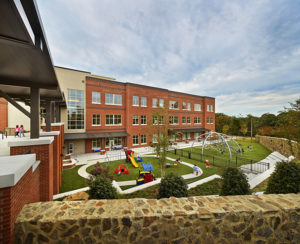The site of a former African-American training school from the 1900s has been transformed into one of the most advanced and well-designed energy-efficient buildings in North Carolina.
Northside Elementary School, which is in Chapel Hill, boasts an extensive history, and now it also boasts promises of an energy-efficient future.
The school was recently awarded Platinum LEED (Leadership in Energy and Environmental Design) certification from the U.S. Green Buildings Council – making it the only school in the state to earn such an honor.
Roughly 40 other schools have also received recognition for their energy-efficient status but never managed to reach the platinum level certification that Northside Elementary has.
What used to be the site of Rosenwald School, a small school building that opened in 1916 specifically to help the advancement of young African-Americans, is now home to rooftop gardens and playgrounds that reduce stormwater runoff.
Moseley Architects is the firm responsible for the eco-friendly, three-story design that supports more than 500 students.
“The design incorporates a garden roof area connected to the adjacent science classroom; a comprehensive stormwater management plan that includes an underground rainwater cistern that supplies water to the toilet fixtures and cooling tower, pervious pavers, and porous playground surfaces; and carefully designed windows, tubular skylights and light shelves to both maximize daylight in classrooms and reduce the energy spent for lighting,” a press release on the Moseley Architects website explains.
The Platinum LEED certification is about more than just being recognized for environmentally friendly efforts.
The certification ensures that the school’s design is actually doing what the architects promised it would.
“A lot of people say that they design to LEED, but they didn’t actually go after [the certification],” said Moseley Architects project manager Ashley Dennis, according to WUNC 91.5, a public radio station in North Carolina. “And that’s great. But it’s kind of taking that next step to say, ‘We’ve designed to this, now we’ve checked behind ourselves. The systems are doing what they say they’re doing. They’re actually saving the energy they were projected to save.’”
The design team also worked alongside the school’s faculty members in order to ensure that the design was able to place an emphasis on the students’ education as well.
“Early in the design process, the idea of using the school building to actively support the curriculum was discussed with key staff members,” the press release said. “Through continued staff input and a healthy collaboration, this idea was not only realized but expanded upon greatly.”
Through the use of “discreetly placed interior and exterior signage” that explain different design features, the building itself has several lessons that it can teach students about helping the environment.
“It allows the students to learn about working with the Earth and being a part of it,” Dennis said.
In addition to being a stunning example of advanced technology and design, the building also still celebrates the site’s history.
“The alumni that had gone to that school had a really rich history. … We didn’t want that to be lost just because the building wasn’t there anymore. So we have a history wall that walks through the history of the site,” Dennis said.
According to Jim Copeland, the managing principal for the project, the elementary school is one of only four elementary schools in the entire country that have achieved Platinum LEED status.
Only 20 public schools in the U.S. have received the same certification.




